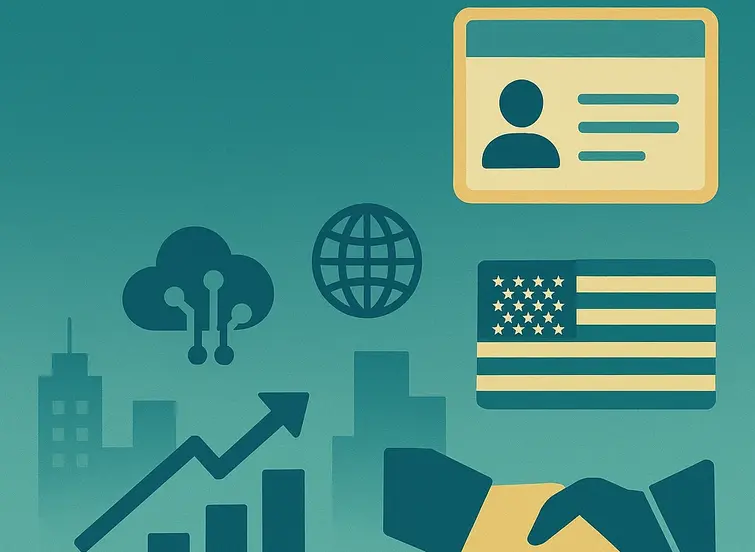H-1B Visa Hiring has become central to a fresh wave of analysis revealing a growing paradox in the U.S. labor market. Despite record numbers of American STEM graduates entering the workforce, top U.S. technology companies continue to favor H-1B visa holders for key roles.
The findings have reignited debates around fairness, transparency, and the long-term implications of immigration and recruitment practices in one of the world’s most competitive industries.
Hire the Best Talent—Wherever They Come From
Post your job on WhatJobs and connect with top global professionals, from U.S. citizens to H-1B visa holders, ready to drive innovation.
Post a Job Now →The H-1B Visa Hiring Advantage in Big Tech
The H-1B visa program, designed to bring highly skilled foreign workers into the U.S., has long been central to Silicon Valley’s workforce strategy. But new data shows that tech giants are recruiting international applicants at disproportionately higher rates compared to American graduates, even when the latter hold comparable qualifications.
Industry insiders cite several reasons:
- Recruitment channels: International students often enter pipelines directly connected to corporate sponsorship programs.
- Wage flexibility: Employers can hire foreign workers at “prevailing wage” levels that may be lower than the expectations of domestic graduates.
- Mobility and commitment: International workers on visas are more likely to accept relocations, overtime, and longer contracts, aligning with corporate needs.
The Domestic Graduate Disadvantage
For U.S. graduates—even those from Ivy League or top-tier STEM schools—the path into Big Tech is less straightforward. Many face structural disadvantages in recruitment processes:
- Opaque job postings: Some companies use internal channels or global mobility systems that aren’t as visible to domestic applicants.
- Networking gaps: International students often rely on strong alumni groups or sponsored career fairs, leaving domestic students outside these circles.
- Perception bias: Recruiters sometimes view visa candidates as hungrier or more willing to endure tough corporate cultures, inadvertently disadvantaging U.S. peers.
This disconnect highlights what economists call the “education-opportunity mismatch”: the U.S. is producing talent but not channeling it into the very industries that say they face worker shortages.
The Policy Landscape: A Shifting Tide
The H-1B visa has always been politically charged. Current debates are intensifying around two issues:
- Visa Lottery vs. Wage-Based Allocation
Policymakers are considering ending the traditional lottery system in favor of selecting applicants based on wage levels. While this could raise skill thresholds, it risks sidelining entry-level foreign graduates with lower starting salaries. - Compliance with Hiring Rules
Critics allege that some corporations skirt H-1B hiring requirements by crafting job ads in ways that deter U.S. applicants, effectively reserving roles for international candidates. This has triggered investigations and calls for stricter oversight.
The Corporate Defense
Big Tech companies defend their hiring strategies, arguing that:
- The U.S. does not produce enough STEM graduates to meet industry demand.
- H-1B hiring ensures access to global talent pools essential for innovation.
- Many H-1B employees remain in the U.S. long term, contributing to entrepreneurship, patents, and new businesses.
Executives emphasize that without international recruitment, companies would risk falling behind global competitors in fields like AI, cybersecurity, and biotech.
The Human Impact
For domestic graduates, the consequences are deeply personal:
- Lost opportunities: Job seekers describe applying to hundreds of roles without feedback, only to see them filled by international hires.
- Career delays: With fewer entry-level roles, many U.S. graduates face underemployment, taking jobs unrelated to their training.
- Wage stagnation: Employers able to lean on global labor pools may have less incentive to raise salaries for local workers.
One recent computer science graduate from California put it bluntly:
“I did everything right—internships, coding bootcamps, top grades. But most postings seemed like they were never really open to me. It’s demoralizing.”
The Globalization Debate
The controversy raises bigger questions about globalization and competitiveness:
- Supporters of H-1B hiring say it makes the U.S. the world’s magnet for elite talent, reinforcing innovation leadership.
- Critics counter that the system undermines American workers, suppresses wages, and disincentivizes companies from investing in domestic training.
Hire the Best Talent—Wherever They Come From
Post your job on WhatJobs and connect with top global professionals, from U.S. citizens to H-1B visa holders, ready to drive innovation.
Post a Job Now →The Numbers Behind the Story
- Nearly 600,000 H-1B visa holders currently work in the U.S., with tech firms accounting for the majority.
- In 2024 alone, the top 10 U.S. tech companies sponsored more than 85,000 H-1B applications, outpacing their hiring of domestic graduates.
- Studies show that for every H-1B hire, an average of 1.8 U.S. applicants were available but not selected.
Sector-Specific Implications
- Software Engineering: H-1B workers dominate junior and mid-level roles, making it harder for new domestic graduates to enter the pipeline.
- Data Science & AI: Companies prioritize international hires with advanced research credentials, often leaving U.S. graduates underqualified.
- Cybersecurity: Demand outstrips supply across the board, but foreign hires still account for 40% of roles at major firms.
- Hardware & Semiconductors: Domestic engineers are underrepresented in chip design and fabrication roles, with global hires filling the majority.
Potential Solutions
Experts and policymakers have floated several remedies to balance opportunity:
- Transparent Recruitment
Require companies to post all positions publicly and make selection criteria visible. - Domestic Talent Investment
Expand federal funding for STEM internships, apprenticeships, and job-readiness programs. - Balanced Visa Reform
Adjust the H-1B program to prioritize high-skill hires while ensuring entry points for U.S. graduates. - University-Industry Partnerships
Build structured pipelines from American universities into major tech firms, modeled after apprenticeship systems abroad.
The Road Ahead
The H-1B hiring gap underscores a fundamental paradox: the U.S. claims to face a shortage of skilled workers, yet homegrown graduates are struggling to land roles in their fields. Without reform, the risk is twofold—domestic talent disillusionment and growing political backlash against global recruitment practices.
Whether the U.S. can strike a balance between embracing global talent and empowering its own graduates will shape the future of the country’s innovation economy.
FAQ: H-1B Hiring Gap in U.S. Tech
Q1: Why do U.S. tech companies prefer H-1B workers over citizens?
Because H-1B candidates often accept lower wages, relocate more easily, and come through established sponsorship pipelines. Companies also argue that there aren’t enough qualified domestic candidates in some fields.
Q2: How does this impact American graduates?
Many face limited job opportunities, underemployment, or career delays despite holding STEM degrees. Entry-level positions are particularly competitive, with international candidates often prioritized.
Q3: Is the H-1B program unfair to U.S. workers?
Opinions differ. Supporters say it attracts world-class talent, while critics argue it suppresses wages and sidelines American graduates. Investigations into compliance suggest some firms exploit loopholes in the system.
Q4: What reforms are being considered?
Opinions differ. Supporters say it attracts world-class talent, while critics argue it suppresses wages and sidelines American graduates. Investigations into compliance suggest some firms exploit loopholes in the system.




